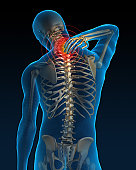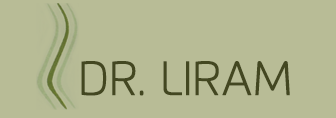Shoulder Pain
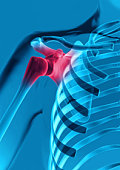 Shoulder pain: why does it happen and how to deal with it?
Shoulder pain: why does it happen and how to deal with it?
Those active in sports’ activities and also, some of those who aren’t, are familiar with this painful and sensitive problem. Shoulder pain can be triggered for a number of reasons:
(a) The shoulder joint’s form is shallow in comparison, for example, with a deep mortar and pistil shaped hip joint. This renders lesser joint stability. Although the shoulder joint does not bear weight, it is dynamically stabilised by ligaments and tendons that provide compensation for bony stability.
(b) Since most of the shoulder’s stability is afforded by these soft tissues, shoulder pain is typically a result of damage to soft tissues, namely muscle tendons and ligaments.
(c) Overloading, aberrant movement and trauma of various types are the main reasons for a painful joint. Some pain may also result from other types of joint disease that are unrelated to overuse or trauma. These diseases usually need specialist diagnosis and will not be discussed here.
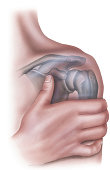
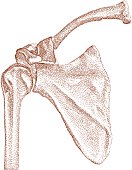 Shoulder: bony anatomy.
Shoulder: bony anatomy.
Looking at the shoulder’s bone structure, we see three bones: The arm bone (vertical) on the left, the shoulder-blade in the middle and the collar-bone [clavicle] connecting to the shoulder blade’s upper part. Between the arm and the shoulder-blade there is a moving (cartilage) joint space and this junction is called the “glenohumeral joint”, which allows the arm to move in all directions. Above this joint is a smaller one, forming the glenohumeral upper border and connecting the shoulder blade to the collar bone. It is called the acromio-clavicular joint. The collar bone connects the shoulder to the chest.
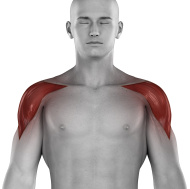 Shoulder: Muscles and ligaments.
Shoulder: Muscles and ligaments.
The deltoid muscle is responsible for most of the shoulder’s gross movement.
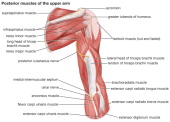 The “rotator cuff” muscles are responsible for the “open and close door” type of arm movement allowing in and out arm rotation.
The “rotator cuff” muscles are responsible for the “open and close door” type of arm movement allowing in and out arm rotation.
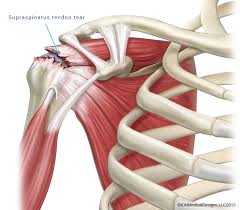 One of the main reasons for shoulder pain is a partial or full tear in the rotator cuff group.
One of the main reasons for shoulder pain is a partial or full tear in the rotator cuff group.
Frozen shoulder:
This pain-causing and limiting disease is caused by an inflamed shrinking of the stabilising ligaments that envelope the shoulder joint, thus restricting movement and causing pain.
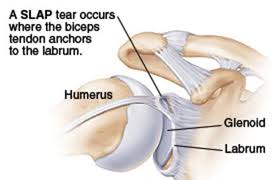 Labrum tear:
Labrum tear:
The “labrum” is Latin for “lip” and forms the cartilage margins of the joint. This tear is common after injury and damages the cartilage between the arm and the shoulder-blade.
 Impingement Syndrome:
Impingement Syndrome:
This is a problem that frequently occurs after too many repetitions of the same movement (overuse), for example, tennis, lifting loads onto shelves, high-load sports such as judo, etc. These activities cause inflamed thickening of the soft-tissues in the narrow space between the collar-bone and the shoulder-blade’s bridge (acromion).
 Comment: Since the shoulder joint is complex and is made up of many ligaments and muscles, accurate examination of the pain or disorder may be afforded by means of imaging. CT and ultrasound are used frequently and MRI (with contrast) provides the best imaging available, if in doubt or after trauma.
Comment: Since the shoulder joint is complex and is made up of many ligaments and muscles, accurate examination of the pain or disorder may be afforded by means of imaging. CT and ultrasound are used frequently and MRI (with contrast) provides the best imaging available, if in doubt or after trauma.
How do we treat all these shoulder problems?
In most cases, shoulder problems may be treated by electronic supported therapy, ultrasound, low level laser therapy (LLLT), manual techniques and rehabilitation exercise. In recent years, Kinesio-Tape plays an important part in shoulder treatment. In some cases, surgery should be considered in order to repair tears in tendons and cartilage or fracture repair. Orthopaedic shoulder specialists carry out these surgical procedures.
Important to remember: Either as a cause or a result, almost all shoulder problems are related to the cervical spine (neck) vertebrae. The nerves emerging from the neck have a great part to play in shoulder problems. This is the reason that chiropractic offers an approach that views shoulder disorders from a spinal standpoint, as well as all the other ones.
